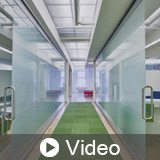
Building Better Spaces: Enhancing Environments with Moveable Walls
The journey started with the foundation of Capitol Wood Works Company in 1929 by Ray H. Neiswander Sr. After a successful establishment, Ray expanded his milling business into the building materials industry and developed Raynor Garage Door Company in 1942. Nineteen years later, a request for an easy-to-move operable partition was answered by turning a garage door section on its side. This revelation sparked the birth of KWIK-WALL Company in 1961.
Moveable walls offer a versatile solution that goes beyond mere spatial flexibility; they contribute significantly to daylight optimization, acoustic performance, utilization of healthy building materials, and enhancement of occupant well-being and comfort. In this course we explore ADA, ASTM, and LEED v4.1 BD+C and ID+C strategies and requirements related to moveable walls. Design professionals will develop the skills necessary to incorporate these principles into their own architectural projects and leverage the benefits of moveable wall systems.
- Explore carefully designed flexible space management through moveable wall systems that can contribute to daylighting, acoustic performance, occupant well-being and LEED v4.1 BD+C and ID+C ratings systems
- Discuss how moveable wall systems can contribute to energy efficiency, thermal comfort, quality views LEED v4.1 BD+C and ID+C credits
- Examine codes and specifications such as ADA, ASTM, WELLv2, and LEED v4.1 BD+C and ID+C ratings systems and how they relate to moveable wall systems
- Review case studies related to moveable wall systems that highlight the benefits for different project applications and how these systems improve occupant well-being





